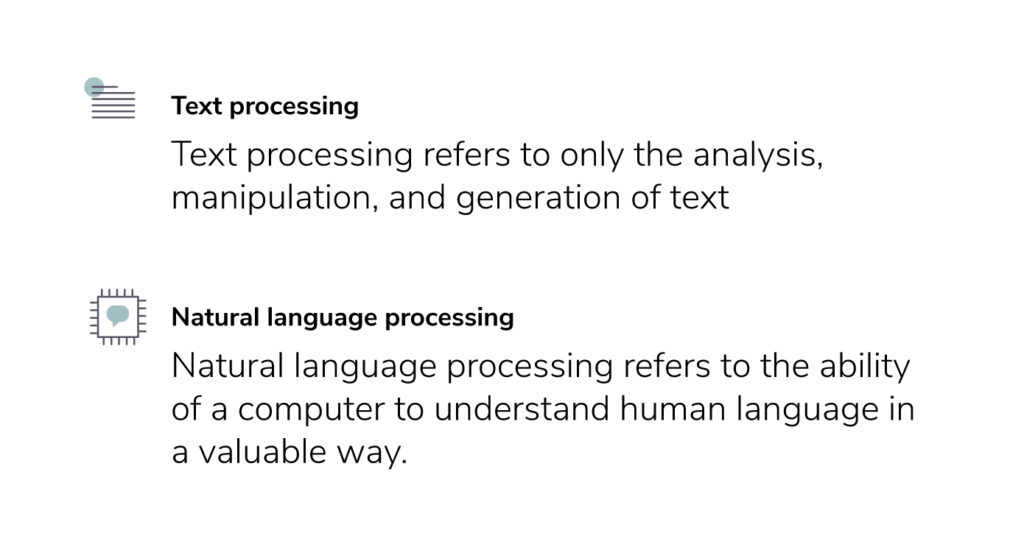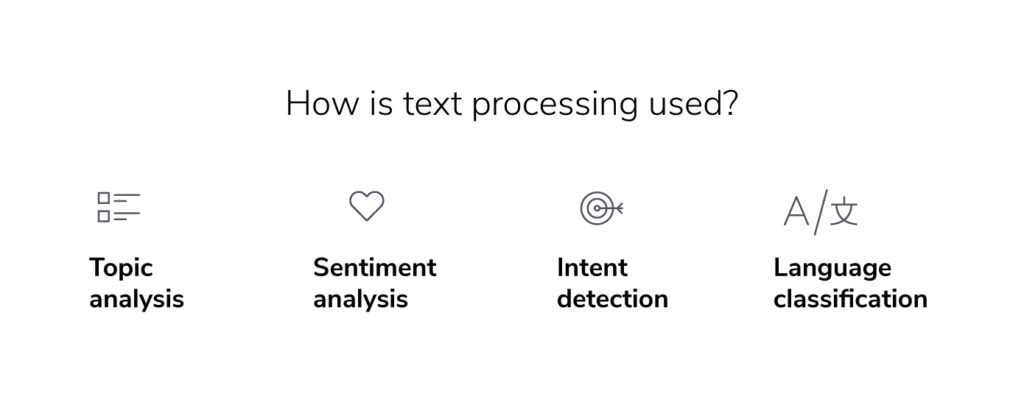This article was originally published at Algorithimia’s website. The company was acquired by DataRobot in 2021. This article may not be entirely up-to-date or refer to products and offerings no longer in existence.
Computing has the power to do some of the things that the human brain can do, thanks to advances in artificial intelligence. One of those advances is text processing, which also relates to natural language processing. This article is a deep dive into what text processing is and how it can generate value for an enterprise.
What is text processing?
The term text processing refers to the automation of analyzing electronic text. This allows machine learning models to get structured information about the text to use for analysis, manipulation of the text, or to generate new text.
Text processing is one of the most common tasks used in machine learning applications such as language translation, sentiment analysis, spam filtering, and many others.
What’s the difference between text processing and natural language processing?
Text processing refers to only the analysis, manipulation, and generation of text, while natural language processing refers to the ability of a computer to understand human language in a valuable way. Basically, natural language processing is the next step after text processing.

For example, a simple sentiment analysis would require a machine learning model to look for instances of positive or negative sentiment words, which could be provided to the model beforehand. This would be text processing, since the model isn’t understanding the words, it’s just looking for words that it was programmed to look for.
A natural language processing model would be translating full sentences into another language. Since syntax varies from one language to another, the computer has to understand the meaning of the sentences in order to accurately translate them. But while NLP is more advanced than text processing, it always has text processing involved as a step in the process.
Why is text processing important?
Since text processing is one of the machine learning uses that average technology consumers don’t even realize they’re using, but most people use apps daily that are using text processing behind the scenes.
Since our interactions with brands have become increasingly online and text-based, text data is one of the most important ways for companies to derive business insights. Text data can show a business how their customers search, buy, and interact with their brand, products, and competitors online. Text processing with machine learning allows enterprises to handle these large amounts of text data.

How is text processing used?
Topic analysis – This technique interprets and categorizes large collections of text into topics or themes.
Sentiment analysis – This function automatically detects the emotional undertones of text and classifies them as positive, negative, or neutral.
Intent detection – This classification model detects the intent, purpose, or goal of the text. For example, it may determine whether the intent is to gain information, make a purchase, or unsubscribe from the company.
Language classification – This classifies text based on which language it’s written in.
How can text processing generate business value?
Text processing allows businesses to automate processes that provide valuable insights, leading to more informed decision making. Customer experience can be greatly improved using automated text processing.
Surveys and reviews
With text processing, a company can analyze their customer surveys or product reviews to classify customers as promoters, passives, or detractors based on their answers to open-ended questions about the brand. This can help determine the health of the company’s customer retention rate, and also determine what offers or information they will receive from the brand via email or elsewhere.
Survey data could be analyzed using keyword extractors to look for a certain word or words in customer answers, topic classification to determine which topics are common among customers, and sentiment analysis to understand what portions of customers feel positive, negative, or neutral about the brand.
Support tickets
Businesses often allow customers to submit customer service support tickets online. This is common for large companies that operate worldwide, and text processing can help make customer support easier to handle. Text processing can determine the topic of the ticket, the urgency of the ticket, and route the ticket to a customer service representative that speaks the same language as the customer. Without machine learning, this would be a time-consuming process to conduct manually.
Data and customer experience are the lifeblood of a company, and they go hand in hand with the help of text processing and other machine learning models. Automating analyses with machine learning improves the accuracy and amount of valuable data a company has, which is crucial when making big decisions. There is no excuse to be making uninformed decisions when you can get accurate data insights about almost anything.
Get Started Today.